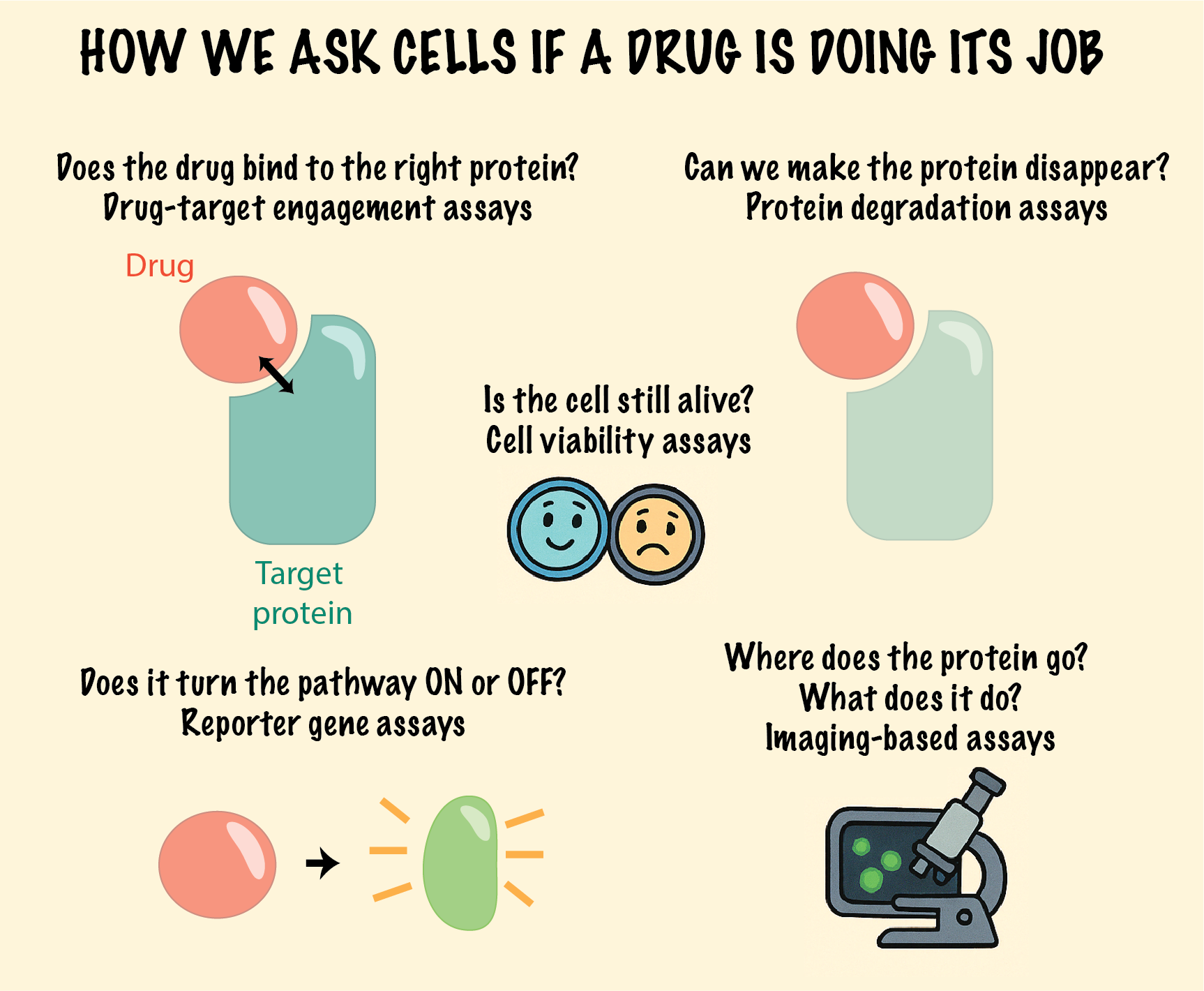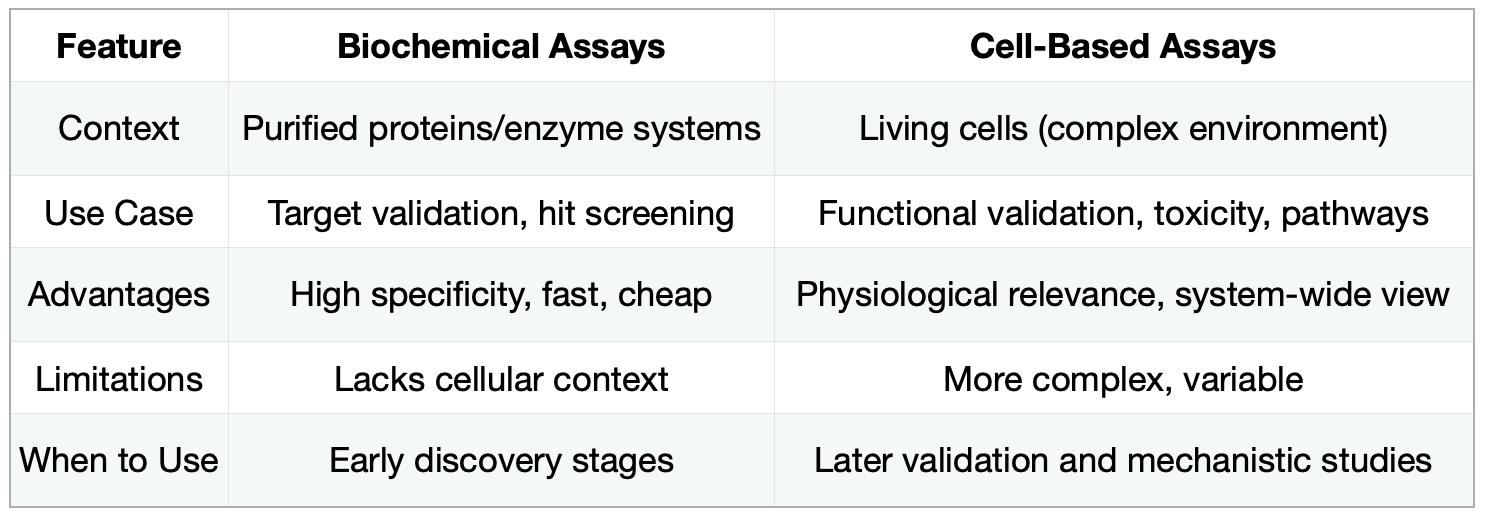Inside the Cell: How Cell-Based Assays Reveal Drug Function
Sometimes I have a hard time explaining to my mom what I do in the lab. So, I decided to take matters into my own hands—and write this post. Not just for her, but for anyone who's ever wondered what actually happens behind the scenes in a biomedical research lab. Whether you’re in the lab, in the office, or just a curious human who likes molecules and mayhem, I hope this article shines a little light on how we turn molecules into medicine.
What Are Cell-Based Assays and Why Should You Care?
In the world of drug discovery, designing a promising molecule is only half the story. Once a compound is synthesized, critical questions emerge: Does it perform its intended function within the cellular environment? Will it bind to the right target protein with sufficient specificity? Can it effectively activate or inhibit the desired cellular functions? And perhaps most importantly, does it avoid triggering unexpected toxicity or side effects that could undermine its therapeutic potential?
Cell-based assays are the tools scientists use to get answers to these questions—by running experiments in living cells. Unlike biochemical assays, which take place in test tubes with purified proteins or enzymes, cell-based assays offer a more realistic snapshot of how drugs behave in a complex, dynamic biological system.
They’re essential (although not sufficient) for:
Understanding the Mechanism of Action (MoA) of a drug
Identifying off-target effects, the non-desired effects of a drug
Evaluating toxicity
Validating computational predictions
And, ultimately, improving our odds of clinical success (because, fun fact: human trials are expensive and not great for wild guesses).
Types of Cell-Based Assays: A Tour Through the Toolkit
In drug discovery, we use many types of cell-based assays, each giving a different kind of readout—that is, a signal or result that tells us something happened, like a glow, a color shift, or fewer cells. Here’s a look at some of the clever tools scientists use to spy on cells in action:
Reporter Gene Assays
Cells have many functions, and reporter genes help us read them. When a signaling pathway is activated (or shut down), these assays respond by producing light or color. For example, a cell might produce luciferase (the same enzyme that makes fireflies glow) when a specific pathway is turned on, allowing us to measure activity with a light detector.
So if your drug is supposed to activate of inactivate one of this functions, reporter gene assays is a great way to tell if your drug is doing its thing. They're great for understanding functional consequences: "Did the cell react the way we hoped?"
Assays to Measure Target Engagement
One of the ways a drug works is by binding to the right protein—like a key fitting into a specific lock. If it clicks, it can trigger or block a biological response. Tools like NanoBRET or CETSA help scientists measure target engagement, that is whether that binding actually happens inside living cells.
NanoBRET uses a clever bioluminescence trick to detect real-time binding events—like catching a protein-ligand first date on camera.
CETSA is weirdly intuitive: heat up your cells, and see which proteins melt. If a drug binds to a protein, it stabilizes it—so it won’t unfold under heat. No tags, no overexpression—just heat, honesty, and a lot of pipetting. A favorite for confirming that a drug is actually engaging its target inside cells.
These assays are perfect for validating computational drug designs—where scientists use computer models to predict how molecules might bind—and structure-activity relationship (SAR) studies, which test how changing parts of a molecule affects its performance. It’s how we go from a promising idea to a drug that actually works.
Protein Degradation Assays: When Disappearance Is the Goal
Some drugs don’t just bind—they bring proteins together. Sometimes to drug a protein the traditional way is difficult, so scientist have come up with alternative ways of inactivating a proteins by just making them disappear. PROTACs, an new type of drug in early stages of research, hijacks the cell’s trash system to break down and destroy the protein in question.
NanoBiT detects the binding of the three elements together: the protein of interest, the protac drug, and the trash machinery using a system that only lights up when the trio unites. Think of it as a glow-in-the-dark soap opera with major therapeutic implications.
When the goal isn’t just to bind a protein—it’s to make it disappear—HiBiT degradation assays come in handy. These assays use a tiny tag to measure the amount of that particular protein over time. When a drug kicks in and the target degrades, the signal fades. You can quantify degradation curves, calculate pharmacological parameters like DC₅₀ (the concentration needed to degrade 50% of the protein), and bask in the glow of clean data.
Viability Assays: The Final Say from the Cell
Did your drug do something useful—or just kill the cell? Viability assays tell you if the cell is alive and kicking after treatment. Methods like MTT (a colorimetric test that measures metabolic activity), CTG (CellTiter-Glo, which measures ATP levels), or colony formation (which tracks if cells can still reproduce) give us this crucial information. These are usually used in combination with other assays to test the activity of the drug.
These are the ultimate functional tests. Because if the cell dies unexpectedly... that’s kind of important.
Imaging-Based Assays: Because Looks Matter
Whether it’s confocal microscopy or high-content screening, imaging lets you actually see what’s happening inside cells. By tagging proteins with fluorescent labels—like little glow sticks—we can track where they go and what they do. Is the protein relocating to the lysosome? Forming nuclear speckles? Melting into the cytoplasm? Imaging adds visual context to your readouts—and sometimes, a glowing green dot really is more convincing than numbers in an Excel sheet.
A visual guide to the key questions we ask in cell-based assays: Does the drug bind its target? Does it activate or block a pathway? Can it degrade a protein, keep the cell alive, or change where proteins go? Each assay type gives us a piece of the puzzle—together, they reveal the full story of how a drug behaves inside a living cell.
Optimization Tips from the Trenches
Behind every good assay is a lot of optimization (and coffee). Here’s what helps:
Choose the right cell model—primary cells or 3D cultures mimic real tissues better than immortalized lines.
Master technical details: pipetting accuracy, cell density, incubation times.
Combine assays for a full picture—phenotypic + biochemical data = gold.
Minimize “edge effects” on plates and always respect the laws of aseptic technique (because contamination is a cruel teacher).
AI + Assays = Power Couple of the Future?
AI is making waves in assay design, especially in high-throughput settings. Deep learning models can analyze image-based data, predict compound effects, and even optimize experimental conditions. AI and computational biology power can also help discover new molecules/drugs with the wanted characteristics from the vast chemical space, narrowing down billions of potential compounds to the most promising candidates for testing in our cell-based assays.
Why is this a big deal? Because bringing a drug to market costs $1–3 billion and takes over a decade. AI offers a faster, cheaper, smarter path—especially when paired with the kind of rich, multidimensional data that modern assays produce.
Biochemical vs. Cell-Based Assays: The Dynamic Duo
Let’s not pit them against each other—biochemical and cell-based assays are partners, not rivals. I just happened to choose cell-based assays to talk about today, but they work best together—biochemical screens narrow down the field, while cell-based assays pick the winners.
A side-by-side comparison of biochemical and cell-based assays, highlighting how each contributes unique insights to drug discovery. While biochemical assays offer precise control and clarity, cell-based assays provide context and complexity—making them complementary tools in understanding drug function.
Final Thoughts: Why Cell Assays Matter
Cell-based assays are like the backstage passes of drug discovery—they show us what really happens inside living systems. They help us move from molecular theories to biological reality.
And as these assays evolve—with better models, 3D cultures, and AI integration—we're not just getting closer to the cell. We’re getting closer to safer, smarter, more effective medicines.
So the next time someone asks me what I do in the lab, I’ll just say: “I help discover how drugs work inside cells, using glowing proteins, fluorescent microscopes, and data-driven analysis to bring new medicines to life.”
Would you like to stay updated on the latest breakthroughs in biomedical science? Subscribe to my blog and join me in exploring the next frontier of medicine!
